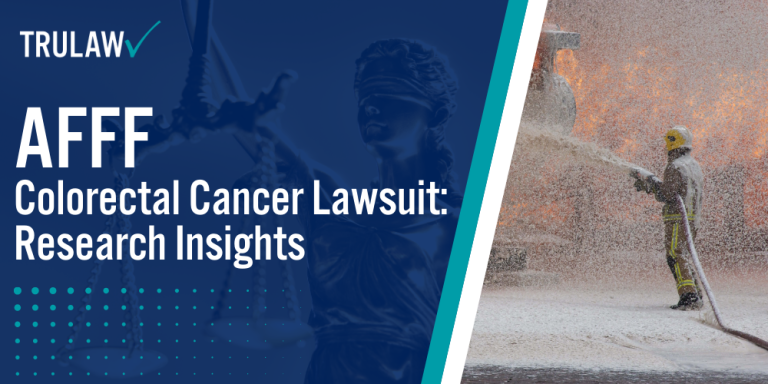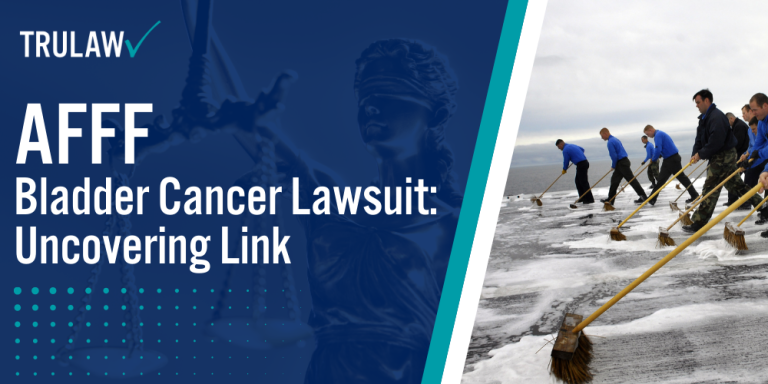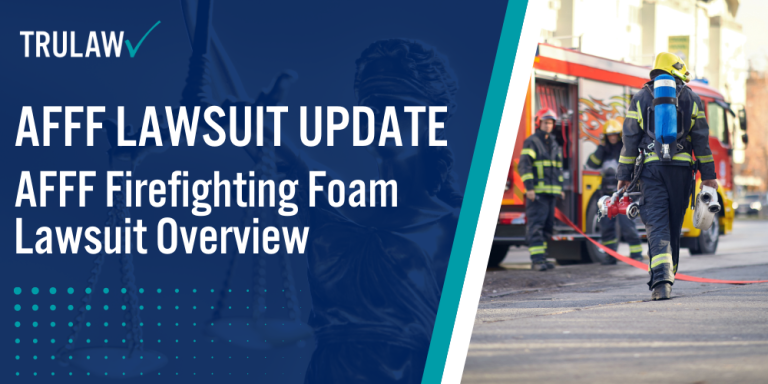AFFF Prostate Cancer Lawsuit: Increased Risk
- Last Updated: July 9th, 2024

Attorney Jessie Paluch, founder of TruLaw, has over 25 years of experience as a personal injury and mass tort attorney, and previously worked as an international tax attorney at Deloitte. Jessie collaborates with attorneys nationwide — enabling her to share reliable, up-to-date legal information with our readers.
Legally Reviewed
This article has been written and reviewed for legal accuracy and clarity by the team of writers and legal experts at TruLaw and is as accurate as possible. This content should not be taken as legal advice from an attorney. If you would like to learn more about our owner and experienced injury lawyer, Jessie Paluch, you can do so here.
Fact-Checked
TruLaw does everything possible to make sure the information in this article is up to date and accurate. If you need specific legal advice about your case, contact us by using the chat on the bottom of this page. This article should not be taken as advice from an attorney.
Key takeaways:
- These legal actions contend that individuals who frequently handle AFFF are at a heightened risk of developing cancer and other health issues, including prostate cancer.
- The history of AFFF use in firefighting, combined with evidence of harmful effects, has empowered plaintiffs to seek legal remediation.
- Legal proceedings are coalescing into a class action MDL (Multi-District Litigation) to handle the growing number of claims efficiently.
Overview of the AFFF Prostate Cancer Lawsuit
On this page, we’ll discuss an overview of the AFFF Prostate Cancer Lawsuit, projected settlement amounts in the AFFF Prostate Cancer Lawsuit, how to determine if you qualify to file an AFFF Prostate Cancer Lawsuit, and much more.
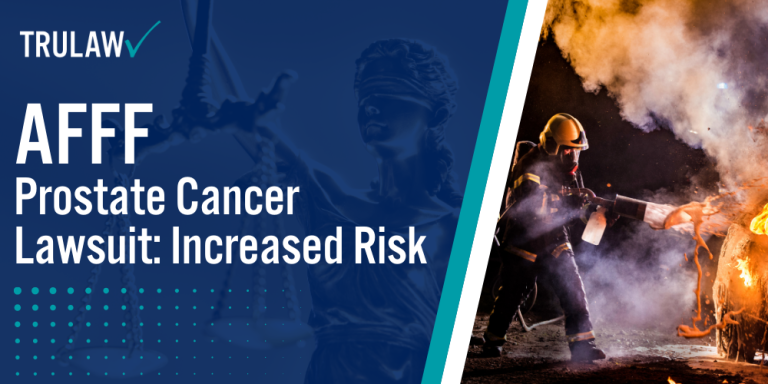
Intro to the AFFF Prostate Cancer Lawsuit
Recent AFFF prostate cancer studies such as the Cancer Incidence and Mortality among Firefighters provide the following insights:
- An increased risk among firefighters for several cancer types, including rectal, prostate, bladder, and testicular cancers
- It also notes an increased risk of mesothelioma and malignant melanoma compared to the general population.
- Consistency in results across various studies indicates a higher frequency of specific cancers among firefighters and military personnel.
- Firefighter John Wilkes claimed that his prostate cancer was caused by exposure to chemicals in AFFF during his time as a firefighter.
If you or a loved one has been diagnosed with prostate cancer and have a history of AFFF exposure, you may be eligible to pursue compensation.
Contact TruLaw using the chat on this page to receive an instant case evaluation to file for an AFFF Prostate Cancer Lawsuit.
Table of Contents
AFFF Prostate Cancer Lawsuit: Understanding the Increased Risk
Aqueous Film-Forming Foam (AFFF) has been widely used in firefighting, but its connection to prostate cancer has led to a series of lawsuits.
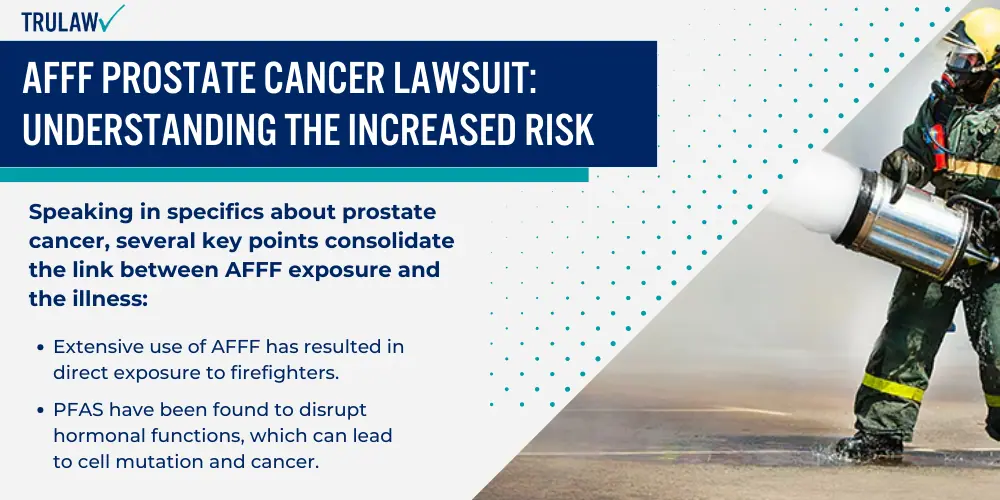
This section looks into the established correlations between AFFF exposure and an increased risk of developing prostate cancer.
AFFF Exposure and Prostate Cancer: Examining the Link
AFFF, commonly used for fire suppression, particularly at military installations and airports, contains perfluoroalkyl substances (PFAS), which have been linked to several health issues.
Speaking in specifics about prostate cancer, several key points consolidate the link between AFFF exposure and the illness:
- Extensive use of AFFF has resulted in direct exposure to firefighters.
- PFAS have been found to disrupt hormonal functions, which can lead to cell mutation and cancer.
- Occupational exposure to these chemicals has led to a surge in cases filed under AFFF lawsuits linked to prostate cancer.
- Research indicates an increased risk of prostate cancer among those exposed to PFAS.
A study has shown an elevated risk for thyroid, kidney, bladder, and prostate cancer among firefighters exposed to PFAS (Perfluoroalkyl substances exposure in firefighters).
This has significant implications for legal actions, as it potentially establishes a causal relationship necessary in AFFF lawsuits.
Historical Analysis of AFFF Use and Prostate Cancer Correlations
The historical use of AFFF has been extensive, particularly in areas that require high-level fire control mechanisms.
However, what’s emerging from a granular inspection is a pattern of health consequences:
- Prostate cancer incidence rates have been correlated with periods of heavy AFFF use.
- Documentation shows consistent usage of AFFF in training and emergency responses.
- Tracking the health records of military firefighters has shown a trend that correlates AFFF exposure with a cancer diagnosis.
- Historical data on AFFF usage and adverse health outcomes increasingly underpin legal claims.
Legal challenges have mounted as a consequence, spotlighting the increased risk factors for prostate and kidney cancer among exposed populations.
The significant historical analysis aids legal representation by potentially offering direct correlational data to support the claims of affected individuals.
The Science Behind AFFF and Prostate Cancer Connections
The increasing scrutiny over AFFF firefighting foam is primarily due to its composition, which contains PFAS chemicals—substances linked to various health issues, including prostate and testicular cancer.
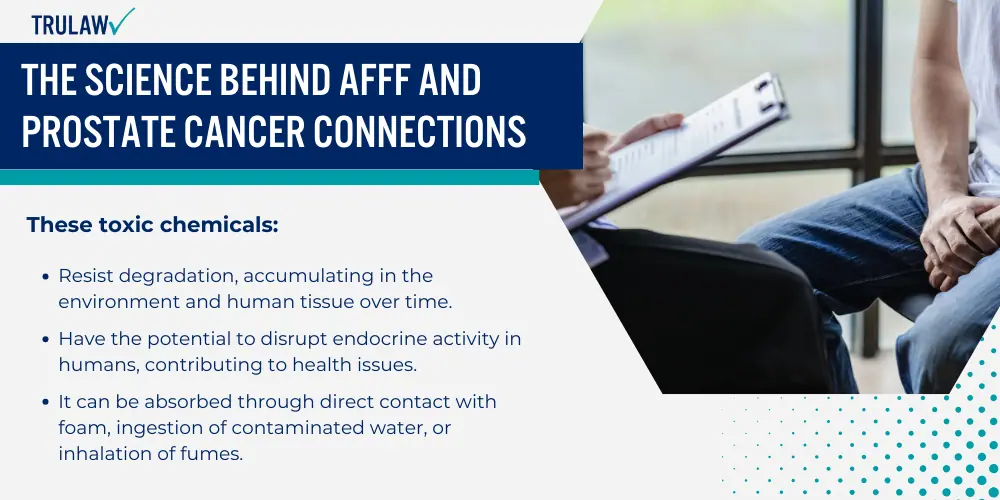
Investigating Chemical Properties of AFFF in Cancer Development
Aqueous Film Forming Foam (AFFF) has been a mainstay in firefighting, particularly in combating oil and gas fires.
Its effectiveness, however, is overshadowed by the presence of PFAS chemicals, which are persistent in the environment and the human body.
These toxic chemicals:
- Resist degradation, accumulating in the environment and human tissue over time.
- Have the potential to disrupt endocrine activity in humans, contributing to health issues.
- It can be absorbed through direct contact with foam, ingestion of contaminated water, or inhalation of fumes.
- They were omnipresent in military and civilian firefighting training and emergency response scenarios, leading to widespread AFFF exposure.
Research indicates these forever chemicals target and alter human cells in a way that may contribute to cancer development.
The Environmental Protection Agency has categorized certain PFAS substances as “emerging contaminants,” suggesting a need for further research and regulation due to concerns about human health.
Scientific Studies Supporting the AFFF Prostate Cancer Lawsuit
Several scientific studies form the basis of the AFFF prostate cancer lawsuit.
Observations show that populations with high levels of exposure to AFFF, such as firefighters, have an increased risk of developing prostate cancer.
Notable findings include:
- A study showed that PFAS alters human prostate stem-progenitor cells, suggesting changes to cell behavior that could heighten cancer risk.
- A population-based study suggests a link between pre-diagnostic serum PFAS concentrations and aggressive prostate cancer.
- Reports of increased cancer risk in communities exposed to the substances, such as Merrimack, NH, due to chronic exposure from industrial sources, including AFFF usage.
- A scoping review highlighting the association between exposure to PFAS and various cancers, with some studies indicating inconsistent data regarding prostate cancer specifically.
These studies, supported by findings that PFAS have been present in most individuals tested, emphasize the potential for AFFF formulations to contribute to prostate cancer risk and the legitimacy of related lawsuits.
Legal Precedents in AFFF Prostate Cancer Lawsuits
Across AFFF litigation, legal precedents have set the tone for how courts handle cases involving alleged prostate cancer due to AFFF exposure.
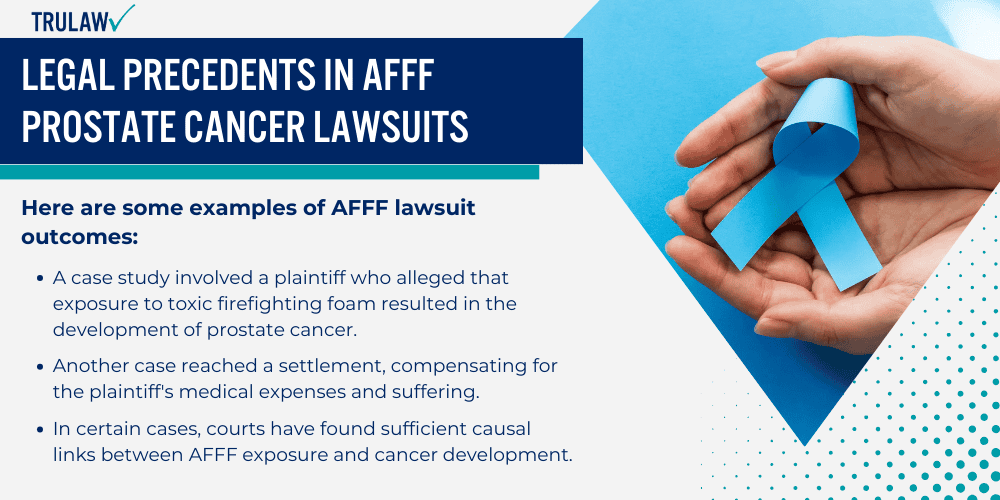
These precedents provide a blueprint for both plaintiffs and defendants in current lawsuits, indicating the potential for legal outcomes.
Notable Case Studies of AFFF Prostate Cancer Lawsuit Outcomes
Legal precedents in AFFF prostate cancer lawsuit outcomes spotlight how courts have ruled on these cases.
Here are some examples of AFFF lawsuit outcomes:
- A case study involved a plaintiff who alleged that exposure to toxic firefighting foam resulted in the development of prostate cancer.
- Another case reached a settlement, compensating for the plaintiff’s medical expenses and suffering.
- In certain cases, courts have found sufficient causal links between AFFF exposure and cancer development.
- A few lawsuits have concluded with jury trials, leading to significant financial awards for plaintiffs.
The specifics of these outcomes help paint a clearer picture of the legal landscape surrounding AFFF litigation.
The Evolution of Legal Arguments in AFFF Cancer Litigations
Over time, the legal arguments presented in AFFF litigation have evolved, influenced by scientific research and prior mass tort cases.
Here’s how legal arguments in AFFF cases have changed:
- Firefighting foam attorneys have refined their strategies, often citing the results of epidemiological studies and internal company documents.
- Defense strategies have also adapted, focusing on critiques of the methodology used in scientific studies that plaintiffs cite.
- The interplay of state and federal regulations regarding chemical exposure has become a focal point in legal arguments.
- Legal arguments have been shaped by both individual lawsuit outcomes and wider regulatory actions, like those taken by the Environmental Protection Agency.
These transformations reflect the adaptive nature of legal approaches in mass tort cases concerning harmful substances.
AFFF Prostate Cancer Lawsuit and Victim Testimonies
The AFFF prostate cancer lawsuit has brought forth numerous personal accounts and impact statements from plaintiffs, shedding light on the alleged correlation between AFFF exposure and prostate cancer development.
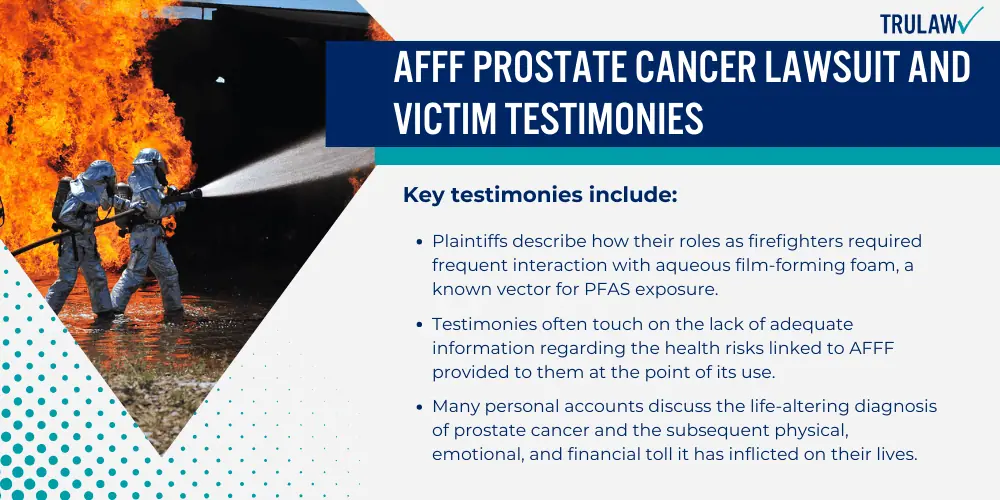
Personal Accounts from AFFF Prostate Cancer Lawsuit Plaintiffs
Victims involved in the AFFF litigation have shared detailed personal accounts that articulate their experiences.
These individuals often mention similar patterns of exposure to AFFF firefighting foam and subsequent health battles with prostate cancer.
Key testimonies include:
- Plaintiffs describe how their roles as firefighters required frequent interaction with aqueous film-forming foam, a known vector for PFAS exposure.
- Testimonies often touch on the lack of adequate information regarding the health risks linked to AFFF provided to them at the point of its use.
- Many personal accounts discuss the life-altering diagnosis of prostate cancer and the subsequent physical, emotional, and financial toll it has inflicted on their lives.
- Plaintiffs in the AFFF prostate cancer lawsuit seek manufacturers’ accountability for what they allege is a negligent disregard for user safety and transparency.
Voice of the Victims: Impact Statements in AFFF Lawsuits
Impact statements in these lawsuits aim to convey the extent of the damage the plaintiffs claim has been inflicted upon them by AFFF exposure.
These statements serve a dual purpose: as a cathartic outlet for victims and as a strategic component in the legal process.
The statements frequently highlight:
- Personal struggles faced by the victims and their families after the diagnosis of prostate cancer, including intensive treatment regimens and their side effects.
- Financial burdens such as medical bills, lost wages, and reduced earning capacity due to the prostate cancer diagnosis and its treatment.
- Emotional distress, including anxiety, stress, and depression, as victims cope with the long-term implications of their conditions.
- A call for justice and appropriate compensation for the alleged negligence by manufacturers of AFFF firefighting foam.
The convergence of these personal accounts and impact statements form a compelling narrative within the broader context of AFFF firefighting foam lawsuits. Across the nation, individuals are turning to experienced AFFF firefighting foam cancer lawyers to present their cases and advocate for recompense in the face of what they assert is considerable suffering caused by PFAS exposure.
Regulatory Actions and AFFF Prostate Cancer Lawsuit Updates
The evolving regulatory landscape and recent legal developments underscore the ongoing concerns associated with Aqueous Film Forming Foam (AFFF) and its alleged link to prostate cancer.
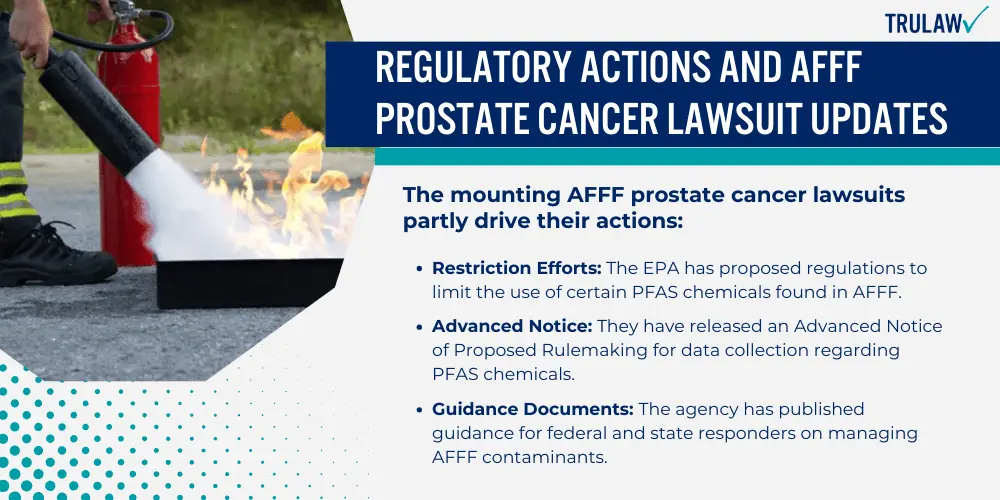
Governmental Policy Changes Following AFFF Cancer Lawsuits
The Environmental Protection Agency (EPA) has been at the forefront of establishing policies in response to the health risks associated with AFFF.
The mounting AFFF prostate cancer lawsuits partly drive their actions:
- Restriction Efforts: The EPA has proposed regulations to limit the use of certain PFAS chemicals found in AFFF.
- Advanced Notice: They have released an Advanced Notice of Proposed Rulemaking for data collection regarding PFAS chemicals.
- Guidance Documents: The agency has published guidance for federal and state responders on managing AFFF contaminants.
- Stakeholder Involvement: Collaborations with stakeholders and the public have been initiated to address contamination concerns.
These changes reflect an acknowledgment of the potential human health implications highlighted by the AFFF class action MDL and individual lawsuits.
The Role of Health Agencies in AFFF Prostate Cancer Lawsuits
Health Agencies are working to determine if there is a link between exposure to aqueous film-forming foams (AFFF) and an increased risk of prostate cancer.
This research is important for firefighters and other personnel who may have been exposed to AFFF in the line of duty.
Health agencies have assumed a critical role in investigating the association between AFFF exposure and prostate cancer:
- Research Initiatives: Agencies like the National Institutes of Health (NIH) have funded studies to explore the health risks of PFAS exposure.
- Expert Testimony: Researchers have provided key insights in court cases, aiding in the understanding of complex scientific data.
- Public Health Advisories: Issuance of advisories informs communities and industries on best practices to mitigate risk.
- Collaborative Assessments: Health agencies work alongside the EPA to evaluate the risk of PFAS compounds to human health.
These agencies’ involvement is integral to the ongoing legal actions addressing the alleged link between AFFF and prostate cancer.
Their expertise supports claims and informs regulatory actions, directly impacting policy changes.
AFFF Prostate Cancer Lawsuit Settlements and Compensation
In recent legal proceedings, AFFF (Aqueous Film Forming Foam) has been linked to prostate cancer among firefighters, leading to a series of lawsuits.
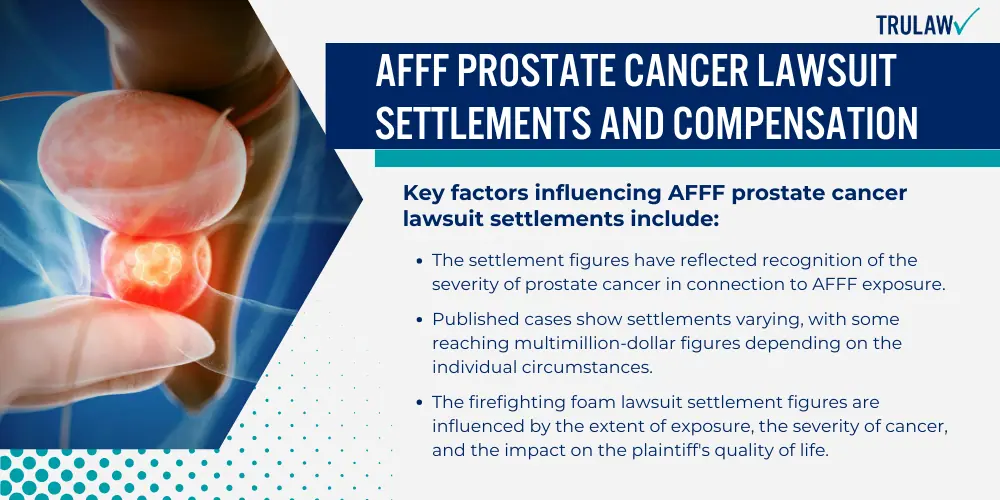
Compensation figures demonstrate the gravity of the situation, as affected individuals seek financial remedy for their suffering.
Trends in AFFF Prostate Cancer Lawsuit Settlement Figures
Lead-in Sentence: Understanding settlement trends is crucial, as it informs current and future litigants about the potential compensation from AFFF prostate cancer lawsuits.
Key factors influencing AFFF prostate cancer lawsuit settlements include:
- The settlement figures have reflected recognition of the severity of prostate cancer in connection to AFFF exposure.
- Published cases show settlements varying, with some reaching multimillion-dollar figures depending on the individual circumstances.
- The firefighting foam lawsuit settlement figures are influenced by the extent of exposure, the severity of cancer, and the impact on the plaintiff’s quality of life.
- There’s a growing trend of group settlements as part of Multi-District Litigation (MDL), providing a streamlined process for resolving numerous related cases.
- The size of settlements has been on the rise as more evidence connects AFFF with cancer risks.
Financial Recourse for Victims in AFFF Prostate Cancer Lawsuits
Victims of AFFF-related prostate cancer have a series of financial recourse options to consider when seeking compensation.
Here are some of the financial avenues available:
- Plaintiffs may receive compensatory damages to cover medical expenses, lost wages, and pain and suffering.
- In certain cases, plaintiffs might also obtain punitive damages intended to punish the defendants and deter future negligence.
- Many lawsuits are being grouped under an MDL to enable more efficient processing of claims and settlements.
- Legal experts suggest securing representation experienced in handling AFFF firefighting foam MDL proceedings to navigate the legal process effectively.
- Settlements potentially include provisions for future medical costs stemming from the long-term effects of prostate cancer.
- Financial recourse options are evaluated on a case-by-case basis, factoring in individual exposure levels and personal damages.
Resources and Support for AFFF Prostate Cancer Lawsuit Parties
Those involved in AFFF prostate cancer lawsuits often require specialized guidance and support systems to navigate legal and medical arenas effectively.
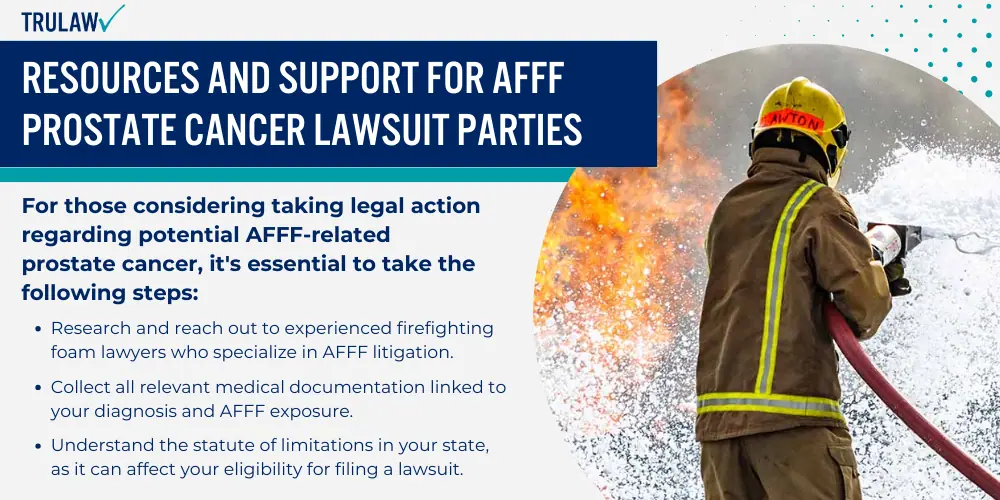
The following subsections provide focused information on available resources for individuals and parties engaged in these lawsuits.
Guidance for Individuals Considering an AFFF Cancer Lawsuit
It is imperative for individuals who suspect their prostate cancer is linked to AFFF exposure to understand the steps needed to file an AFFF lawsuit.
For those considering taking legal action regarding potential AFFF-related prostate cancer, it’s essential to take the following steps:
- Research and reach out to experienced firefighting foam lawyers who specialize in AFFF litigation.
- Collect all relevant medical documentation linked to your diagnosis and AFFF exposure.
- Understand the statute of limitations in your state, as it can affect your eligibility for filing a lawsuit.
- Familiarize yourself with the legal process, including what to expect from initial filings to potential settlement discussions.
- You can engage in preliminary consultations with legal professionals, often offered free of charge, to determine the strength of your case.
Legal and Medical Support Systems for AFFF Lawsuit Plaintiffs
The legal and medical support systems play a vital role for plaintiffs involved in AFFF lawsuits.
To help plaintiffs dealing with AFFF lawsuits, it’s important to consider the following support avenues for justice and holistic care:
- Look for law firms that offer comprehensive services, including legal support throughout the proceedings of an AFFF lawsuit.
- Seek out specialized medical experts who can provide evidence on the connection between AFFF and prostate cancer.
- Research advocacy groups and community organizations that provide emotional and educational support to individuals affected by AFFF.
- Utilize online resources for up-to-date information on the development of AFFF litigation and related medical studies.
It is essential for plaintiffs to have access to robust legal and medical networks to fortify their cases and support their well-being throughout the duration of the lawsuit.
The Future of AFFF Prostate Cancer Lawsuits and Prevention
As the legal and medical communities continue to understand AFFF-related health effects, they are focusing on reducing risks and anticipating changes in litigation.
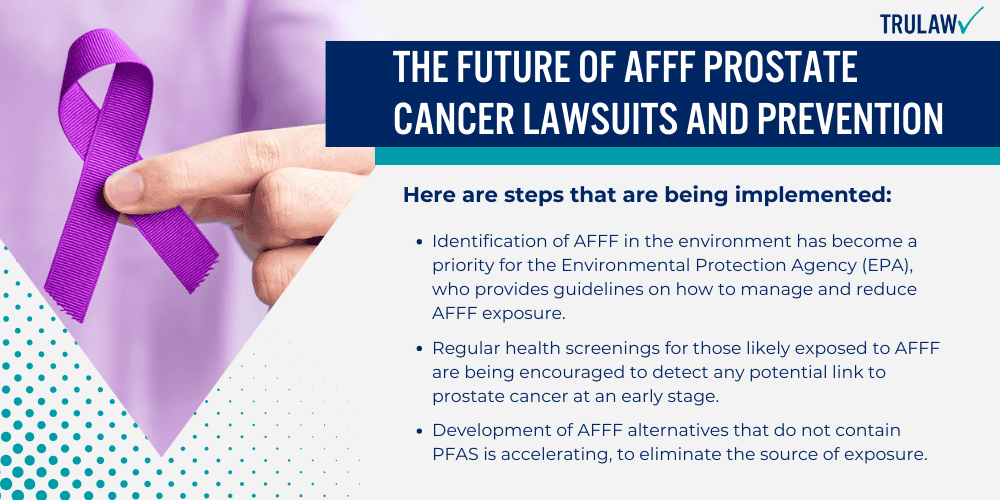
Proactive Measures in Reducing AFFF-Related Cancer Risks
Prevention of prostate cancer related to AFFF begins with understanding the dangers of exposure.
Industries and firefighters are both targeted for improved safety protocols.
Here are steps that are being implemented:
- Identification of AFFF in the environment has become a priority for the Environmental Protection Agency (EPA), who provides guidelines on how to manage and reduce AFFF exposure.
- Regular health screenings for those likely exposed to AFFF are being encouraged to detect any potential link to prostate cancer at an early stage.
- Development of AFFF alternatives that do not contain PFAS is accelerating, to eliminate the source of exposure.
- Employment of personal protective equipment (PPE) and enhanced environmental protection measures during fire suppression and training exercises.
Anticipating Legal Trends in AFFF Prostate Cancer Claims
The landscape of AFFF litigation is dynamic, with new findings constantly shaping the direction of legal proceedings.
Key considerations include:
- Ongoing scientific research will likely influence both the legitimacy of claims and the potential for class-action lawsuits.
- Recognition of AFFF-related prostate cancer as an occupational disease is becoming more prominent.
- The development of a standard of proof linking AFFF exposure to prostate cancer risk is crucial to legal trends.
- The evolving nature of state and federal regulations will likely guide future litigation efforts concerning AFFF prostate cancer claims.
Trulaw: #1 AFFF Prostate Cancer Lawyer
Trulaw stands at the forefront as a leading law firm specializing in AFFF prostate cancer lawsuits.
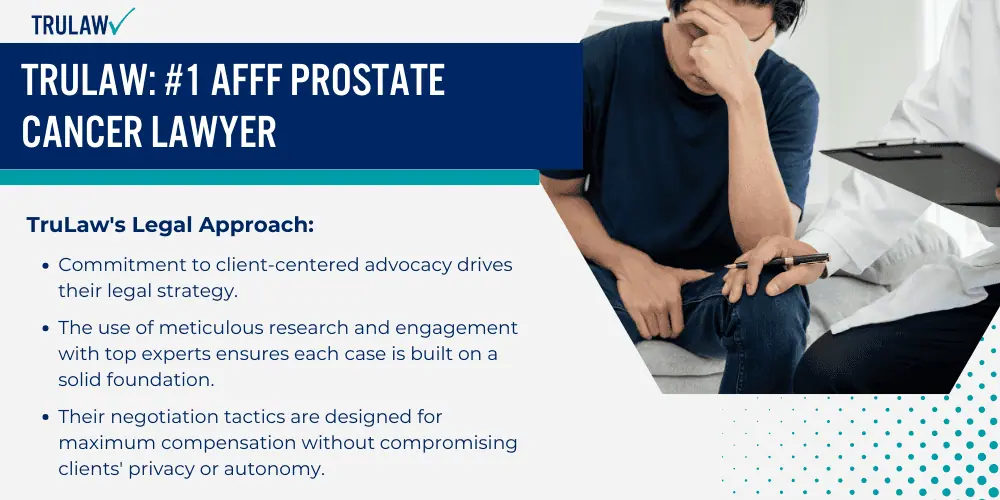
Their team of seasoned attorneys has built a reputation by providing clear, knowledgeable legal guidance for clients affected by prostate cancer due to exposure to AFFF, a firefighting foam.
TruLaw’s Legal Approach:
- Commitment to client-centered advocacy drives their legal strategy.
- The use of meticulous research and engagement with top experts ensures each case is built on a solid foundation.
- Their negotiation tactics are designed for maximum compensation without compromising clients’ privacy or autonomy.
TruLaw emphasizes the importance of results-driven litigation, particularly for firefighters and other individuals who have developed prostate cancer potentially due to AFFF exposure.
Their team is equipped to support the legal rights of those whose health has been jeopardized by these harmful substances.
Trulaw offers reliability and peace of mind in seeking justice for affected individuals through a tactical approach to the legal process.
Frequently Asked Questions
-
What factors determine the settlement amounts in AFFF-related lawsuits?
The settlement amounts in AFFF-related lawsuits are typically determined by factors such as the extent of contamination, health impacts, and the strength of evidence linking the AFFF exposure to the damages claimed.
Additionally, the involvement of multiple defendants and their respective levels of liability can also influence the settlement amounts in these lawsuits.
-
How are Navy personnel affected in AFFF litigation?
In AFFF litigation, Navy personnel may be affected by potential exposure to per- and polyfluoroalkyl substances (PFAS) present in AFFF, which could have health and environmental implications.
It’s important for Navy personnel to stay informed about any developments in AFFF litigation and to seek appropriate legal and medical guidance if they believe they have been affected.
-
What is the expected time frame for the resolution of AFFF lawsuits?
The expected time frame for resolving AFFF lawsuits can vary widely depending on the specifics of each case, but it’s not uncommon for these types of lawsuits to take several years to resolve.
It’s important to consult with a legal professional, such as TruLaw for specific guidance on your individual situation.
-
What are the latest developments in ongoing AFFF litigation?
The latest developments in ongoing AFFF litigation include an increasing number of lawsuits being filed against manufacturers and users of AFFF due to its environmental and health impacts.
Additionally, some cases have resulted in significant settlements and verdicts in favor of the plaintiffs, signaling potential liability for AFFF manufacturers and users.
-
What are the eligibility criteria for participants in the AFFF lawsuit?
The eligibility criteria for participants in the AFFF firefighting foam lawsuit may include being a current or former military firefighter, living near a military base where AFFF was used, or having been diagnosed with certain health conditions linked to AFFF exposure.
It’s best to consult with a legal professional for specific details regarding eligibility.

Experienced Attorney & Legal SaaS CEO
With over 25 years of legal experience, Jessie is an Illinois lawyer, a CPA, and a mother of three. She spent the first decade of her career working as an international tax attorney at Deloitte.
In 2009, Jessie co-founded her own law firm with her husband – which has scaled to over 30 employees since its conception.
In 2016, Jessie founded TruLaw, which allows her to collaborate with attorneys and legal experts across the United States on a daily basis. This hypervaluable network of experts is what enables her to share reliable legal information with her readers!
You can learn more about the AFFF Lawsuit by visiting any of our pages listed below:
Here, at TruLaw, we’re committed to helping victims get the justice they deserve.
Alongside our partner law firms, we have successfully collected over $3 Billion in verdicts and settlements on behalf of injured individuals.
Would you like our help?
At TruLaw, we fiercely combat corporations that endanger individuals’ well-being. If you’ve suffered injuries and believe these well-funded entities should be held accountable, we’re here for you.
With TruLaw, you gain access to successful and seasoned lawyers who maximize your chances of success. Our lawyers invest in you—they do not receive a dime until your lawsuit reaches a successful resolution!
Do you believe you’re entitled to compensation?
Use our Instant Case Evaluator to find out in as little as 60 seconds!
Camp Lejeune’s water contamination issue spanned several decades starting in the 1950s. Exposure to these chemicals has been linked to various serious health issues, including cancer, organ diseases, and death.
Research is increasingly suggesting a link between the use of Tylenol during pregnancy and the development of neurodevelopmental disorders, such as autism and ADHD, in infants.
Legal action is being taken against manufacturers of Aqueous Film-Forming Foam (AFFF), a chemical used in fighting fires. The plaintiffs allege that exposure to the foam caused health issues such as cancer, organ damage, and birth and fertility issues.
Here, at TruLaw, we’re committed to helping victims get the justice they deserve.
Alongside our partner law firms, we have successfully collected over $3 Billion in verdicts and settlements on behalf of injured individuals.
Would you like our help?
